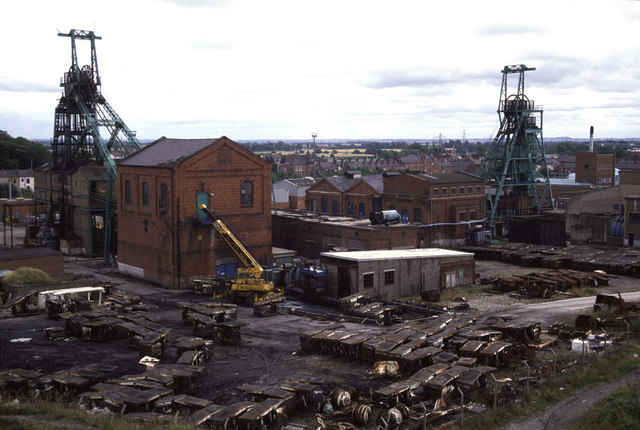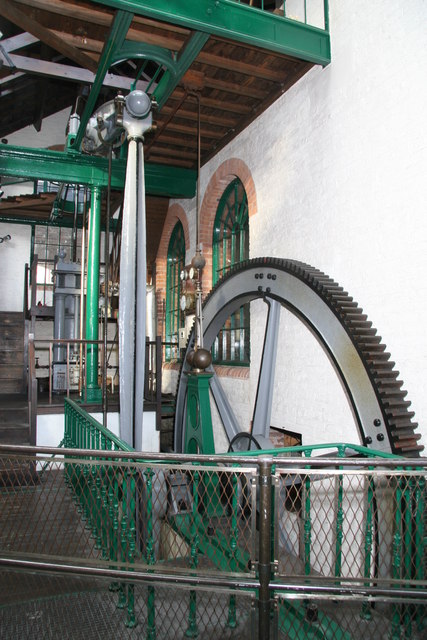
Wikimedia Commons
Haydock Collieries comprised several pits, some started in the 18th century, on land owned by the Leghs of Lyme around Haydock on the Lancashire CoalfieldThe Lancashire and Cheshire Coalfield in North West England was one of the most important British coalfields. Its coal seams were formed from the vegetation of tropical swampy forests in the Carboniferous period more than 300 million years ago. in north-west England. Richard Evans bought the Legh share of Turner and Legh after first acquiring Edge Green Colliery in 1830. After Turner’s death in 1847, the company became Richard Evans & Sons. Some pits were connected underground for ventilation and coal winding. Mining disastersMining disasters in Lancashire in which five or more people were killed occurred most frequently in the 1850s, 1860s and 1870s. , mostly explosions of firedampDamps is a collective name given to all gases other than air found in coal mines in Great Britain. The chief pollutants are carbon dioxide and methane, known as blackdamp and firedamp respectively. , occurred in several pits, the worst was an explosion at Wood Pit that killed 189 men and boys on 7 June 1878.
Background

Wikimedia Commons
The shallow coal measures around Haydock were worked from at least the 18th century when the major landowners were the Leghs of Lyme.[1] Around 1830, the collieries, which had a horse-drawn tramway connection to the Sankey Canal, were owned by Thomas Legh and William Turner. A year later their collieries were connected to the railway network by a mineral line to the Warrington and Newton Railway at Newton Junction.[1]
Richard Evans, (1778–1864), a printer from Paternoster Row in London, bought a share in Edge Green Colliery in Golborne in 1830. He bought Legh’s share of Turner and Legh’s business, which took the name Turner & Evans. When Turner died, in 1847, Evans acquired his share and the firm became Richard Evans & Sons. Two of Evans’ children, Josiah (1820–1873) and Henry (1823–1878) followed their father into the business.[2] The company remained in the Evans’ family ownership until 1889 when it became a public limited company and remained as such until the formation of the National Coal Board in 1947.[3]
Pits
The Haydock pits had access to considerable coal reserves but the workings were subject to flooding. Ram Pit sunk in 1901 never went into production because of flooding. Some pits were connected underground to rationalise winding operations and facilitate ventilation.[4] In 1890 eight pits were working.
Four of the company’s pits survived to become part of the National Coal Board (NCB) in 1947. They were Golborne, Lyme Pits, Wood Pit and Old Boston which together employed 3,195 underground and 557 surface workers.[5] The NCB’s St.Helens Area Central Workshops were at Haydock until 1963.[6]
The company owned several pits in and around Haydock.
- Brynn Pit opened around 1870 and lasted until 1919.[7]
- Downhall Green commenced winding in 1860 and lasted for 25 years.[7]
- Edge Green opened before 1830 and finished winding coal in 1920.[7]
- Engine Pit began winding in 1853 and finished in 1854.[7]
- Golborne Colliery was started by Edward Johnson in 1878 and was bought by Evans and Company in 1880. It was still working 100 years later.[7] In 1975 nearly 1000 men worked at the pit taking coal from the Crombouke, Lower Florida and Ince Six Feet mines.[8]
- After Haydock Colliery closed, its workshops became the NCB Workshops. Its single-cylinder beam engine, used to drive the machinery until 1954, has been preserved.
- King Pit opened in 1891.[7] It was connected underground to the Princess, Queen and Legh Pits.[4]
- Legh Pit opened in 1855 and closed in 1911.[7]
- Lyme Pit was started in 1876 but was shaft sinking was abandoned because the ingress of water could not be overcome by the technology of the time. Work recommenced in 1912 but was interrupted by the onset of the First World War. In 1919 shaft sinking again resumed and the first coal was produced in 1922. The colliery had three shafts. The downcast shaft, No. 1 was 395 yards (361 m) deep and wound coal from the Florida seam. The upcast shaft, No. 2, wound coal from the Potato Delf and Wigan Four Foot mines and No 3 shaft was used for pumping.[9] The Lyme Pit disaster occurred in February 1930 killing 13 men.[9] In 1964, 419 miners and 187 surface workers were employed. The pit closed in March that year.[10]
- New Boston Colliery was sunk in 1854 and lasted until 1910.[11]
- New Whint began winding coal in 1853 and finished a year later.[7]
- Newton Colliery was operational in 1896 and was nationalised in 1947.
- North Florida Pit was sunk in 1861 and wound coal until 1870.[7]
- Old Boston Pit began winding coal in 1868 and closed in 1952.[7] On 29 June 1900, eight workers were killed when pockets of gas were encountered while shaft sinking.[15] The deepest of its three shafts reached 476 yards. The pit closed after an underground fire in 1952. From 1953 until 1989 the pit-head buildings were used as the Area Training Centre for miners.[11]
- Old Fold commenced winding coal in 1850 and closed in 1864.[7]
- Old Whint began winding coal in 1853 and closed the same year.[7]
- Parr Colliery Nos 1 and 2 shafts were sunk in 1871 and wound coal until 1926. Nos 3 and 4 shafts were sunk in 1893 and finished winding coal in 1931.[7] No 3 shaft was possibly the Havannah Pit which opened in 1863 and closed in 1889.[4]
- Pewfall Pit opened in 1860 and closed in 1911.[7]
- Princess Pit began winding in 1892 and was worked until 1920.[7] It was linked underground to the King, Queen and Legh Pits.[4]
- Queen Pit opened before 1849 and closed in 1920.[7] On 26 December 1868 an explosion killed 26 workers.[12] It was linked underground to the King, Princess and Legh Pits.[4]
- Ram Pit, sunk in 1901, never went into production because of flooding.
- Wood Pit was sunk in 1866. It closed in 1971.[7]
Disasters

Wikimedia Commons
An explosion of firedamp in May 1831 killed up to twelve workers and the following May another explosion killed another six at the Haydock Collieries.[13] On 26 December 1868 an explosion killed 26 workers in the Queen Pit.[12] An explosion at Wood Pit on 7 June 1878 killed 189 men and boys.[14] The Lyme Pit disaster occurred in February 1930 when 13 men died.[9]
Haydock Foundry

Wikimedia Commons
Haydock Foundry produced six 0-6-0 well tank steam locomotives which were designed by Josiah Evans for the company. They had outside Gooch valve gear and piston valves. They were named Amazon (built 1868), Hercules (1869), Makerfield (1874), Bellerophon (1874), Parr (1886) and Golborne (1887). The locomotives were broadly similar but had some detail differences. The first two had valves driven by rocking levers. The last four had direct drive to the valves. Working pressure was initially 120 psi but was raised to 140 psi and then 160 psi. Josiah Evans died in 1873 and Smallwood attributes the design changes to his assistant, James Forrest.[15]
Colliery railways
The pits were served by railways that linked to the Liverpool and Manchester Railway and the Warrington and Newton Railway. Excepting Edge Green and Golborne Collieries, all Evans’ pits were connected to the company’s private railway network.[16]
The earliest locomotives for use on the colliery system were obtained from the Vulcan Foundry and Jones and Potts. Little is known about them other than they were mostly tender locomotives of 0-4-0, 0-4-2 or 2-4-0 wheel arrangement. By 1864, 25 locomotives had been purchased.[17]
